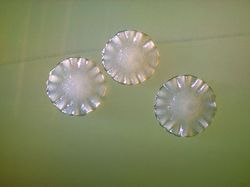Actinomycetes Overview
Introduction
The actinomycetes comprise a group of procaryotes that have the ability to form Gram-positive, branching filaments of less than 1μm in diameter. The main animal pathogens in the actinomycetes are the genera Actinomyces, Nocardia and Dermatophilus.
Streptomyces species are also included in this group, and they are prolific producers of antimicrobial substances.
Actinomyces species
Morphology and Staining
These are gram-positive diphtheroid or filamentous rods, about 0.5μm in width. Branching filaments are usually found in pathological specimens. In culture, diphtheroid forms predominate.
Structure and Composition
Actinomyces species have distinctive cell wall constituents. Surface fibrils in A. viscosus may be adhesins for host cells or other bacteria. Surface antigens are related to chemotactic and mitogenic activities.
Growth Characteristics
Animal Actinomyces species are capnophilic or facultative anaerobes. All require rich media, preferably containing serum or blood. No growth occurs on Sabouraud's agar. Development of macroscopic colonies may require several days at 37°C. Colonical morphology varies between and within species.
Biochemical Activities
Actinomyces are catalase-negative, with the exceptions of A. viscosus and A. canis.
Reservoir
Actinomyces species live in the nasopharyngeal and oral mucosa, and secondarily in the gastrointestinal tract.
Disease
Actinomyces species evoke pyogranulomatous reactions by unknown mechanisms. Bacterial colonies trigger the suppurative response, and there is also granulation, mononuclear infiltration and fibrosis.
Sinus tracts carry the exudate to the outside. This often contains 'sulfur granules' which are bacterial colonies surrounded by clubs.
Diseases caused by Actinomyces species include:
- Ruminants: A. bovis causes lumpy jaw.
- Horses: Actinomyces species have been isolated from cases of Poll Evil and Fistulous Withers as well as in cases of cervical lymphadenitis.
- Dogs and cats: Actinomyces are common causes of pyonecrotic processes, usually associated with a foreign body such as a migrating grass awn. Commonly isolated species include: Actinomyces viscosus, Actinomyces hordeovulneris, A. canis, A. catuli.
- Pigs: mastitis, pneumonia and abortion have all be associated with Actinomyces infections.
Nocardia species
Morphology and Staining
Gram-stained Nocardia species are indistinguishable from Actinomyces species. They are partially acid-fast so a Ziehl-Neelsen stain would differentiate them from Actinomyces. They alternate between the coccobacillary resting phase and the actively-growing filamentous forms.
Structure and Composition
The cell wall is typical of gram-positive bacteria. It contains a high concentration of lipids. A superoxide dismutase acts as a virulence factor.
Growth Characteristics
Nocardia species are obligate aerobes growing on simple media (Sabouraud's) over a wide temperature range. Colonies are opaque and variously pigmented. The colony surface, which is waxy to powdery to velvety depending on the abundance of growth, wrinkles with age. The diameter of colonies may reach several centimetres.
Biochemical activities include catalase production and acidification of various carbohydrates.
Reservoir
Pathogenic Nocardia species are saprophytic and found in many climates in soil and water, either as indigenous flora or as contaminants.
Disease
Nocardia species survive within phagocytic vacuoles and lead to a predominantly suppurative process. Lymph nodes are consistently involved. Exudates are serosanguinous and sometimes contain 'sulfur-granule-like' debris, which lack the microstructure of Actinomyces sulfur granules.
Diseases in different species include:
- Ruminants: mastitis, bovine farcy, pneumonia, abortion and lymphadenitis
- Horses: local or general infections due to underlying immunosuppression (EPPID), placentitis which causes abortion
- Dogs and cats: pneumonia, suppurative pleuritis with empyema, dissemination to kidneys, CNS, bones, joints
- Pigs: pneumonia, abortion, lymphadenitis
Dermatophilus species
Dermatophilus congolensis is the only species, and is a gram-positive filamentous bacterium.
Morphology and Composition
The reproductive unit of the bacterium is the motile coccoid zoospore. Upon germinating, the zoospores sprout a germ tube which elongates and thickens, dividing transversely and longitudinally, forming a strand several layers thick. Multiflagellated zoospores are liberated as the strand disintegrates.
Growth Characteristics
D. congolensis grows on blood media, but not on Sabouraud's agar. It is aerobic and capnophilic. Haemolytic colonies develop within 48 hours and vary from mucoid to viscous and waxy and whitish-grey to yellow. Catalase, urease and proteases are produced. The bacterium survives well in the soil and on fomites.
Reservoir
D. congolensis does not multiply saprophytically. Its reservoir is infected animals. Cattle, sheep, goats and horses are common hosts but it has been diagnosed in many other animals.
Disease
It causes an exudative dermatitis, with activity confined to the living epidermis. There is a scab consisting of layers of neutrophilic exudate and keratinising epidermis. Wetting favours expansion of the lesions.
It causes lesions on the back (rain scald in horses, lumpy wool in sheep), feet and legs (strawberry footrot in sheep and grease heel in horses).
Streptomyces species
These are not pathogenic but are similar to Nocardia species in cultures. Some species produce antibiotics, and they are common laboratory contaminants.
| Actinomycetes Overview Learning Resources | |
|---|---|
 Test your knowledge using flashcard type questions |
Cytology Q&A 02 |
References
Quinn, P. (1994) Clinical veterinary microbiology Elsevier Health Sciences
Hirsh, D. (2004) Veterinary microbiology Wiley-Blackwell
| This article has been peer reviewed but is awaiting expert review. If you would like to help with this, please see more information about expert reviewing. |
Error in widget FBRecommend: unable to write file /var/www/wikivet.net/extensions/Widgets/compiled_templates/wrt695a5ef3aee314_30571666 Error in widget google+: unable to write file /var/www/wikivet.net/extensions/Widgets/compiled_templates/wrt695a5ef3b818d6_89112305 Error in widget TwitterTweet: unable to write file /var/www/wikivet.net/extensions/Widgets/compiled_templates/wrt695a5ef3c3f680_40838010
|
| WikiVet® Introduction - Help WikiVet - Report a Problem |
